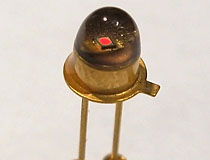
 |
| LEDs & Solid State Indicators |
Light emitting diodes were developed as a cheap, reliable solution for both indicator lamps and character displays, and were compatible with the rapidly evolving transistor technology of the 1960s. Though solid state light emission is believed to have been first observed in 1907 by Henry Joseph Round of Marconi while working on a silicon carbide detector, it would take over 50 years for LED indicators to reach a a state of availability. Subsequent research by Oleg Vladimirovich Losev, Gary Pittman and Bob Biard from Texas Instruments, and Nick Holonyak of General Electric, produced patents and laboratory light sources, but no commercially viable products. It was not until the Monsanto corporation and Hewlett Packard entered into a joint LED development program in the late 1960s that the first commercially mass produced LEDs entered the market. These early devices were extremely dim and quite different looking from a modern LED, but kicked off an industry that would grow to be worth $30 billion by the 21st century. |
|
| Monsanto MV1 | |
The Monsanto MV1, released in 1968, is considered by most LED collectors to be the world's first commercially produced visible light emitting diode. As can be expected, the MV1 bears only a loose resemblance to a modern epoxy-packaged LED. The semiconductor material is packaged in a gold plated metal can, similar to the TO-18 can packages used for many transistors. There is no reflector as seen in later LEDs. The diode die is mounted directly to a characteristic 'anvil head' contact surface in the bottom of the package, a technique that can be seen in many first generation LEDs. Under magnification, the GaAsP emitting sector can be seen as a circular void surrounded by an upper contact that covers all of the unused space on the top of the die. As expected, the MV1 is a very dim light source, and is barely visible under normal indoor lighting. It should be noted that until relatively recently, many collectors falsely identified this device as a Monsanto MV2. This is inaccurate: the MV2, though packaged similarly, is a green-emitting LED device. |  |
| Green Straight Pin LED (Unknown P/N) | |
Straight-pin LEDs are a package style that was quickly phased out during the early days of LED production, and as a result were largely only available in red or IR versions. Green is a strange color to find in such a package type, especially a GaP green chemistry die like the one used in this unidentified LED. This LED also has other obvious evidence of its late production...a second lead has been spot welded to the outside of package, which allows it to be inserted into a standard 3mm LED footprint. Unfortunately we do not know the part number or manufacturer for this device. If you can identify the part number for this LED, please contact us. |  |
| ©2000-2025 Industrial Alchemy. All rights reserved. | Switch to mobile version | Contact | |  |